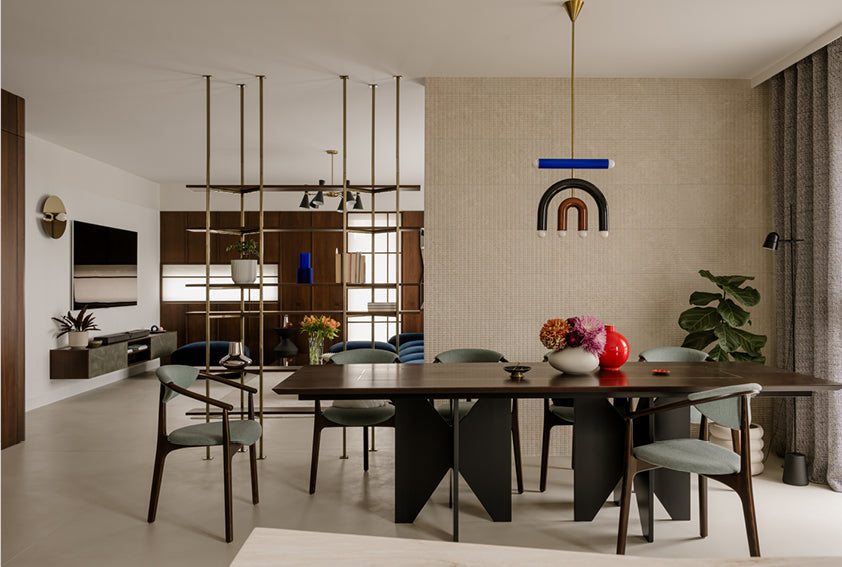
How to Hide Damaged Walls
We’ve got a project in the works at CHD that involves disguising a damaged wall, and it got us thinking—at some point, everyone ends up with a wall that’s seen better days. Life is tough on walls.
Maybe it’s that mystery dent that definitely wasn’t there before your kids got rollerblades. Maybe it’s a tear in the drywall from a "simple" mirror installation gone rogue. Or maybe it’s just decades of wear and the emotional toll of beige paint. Whatever the culprit, you’re left with a wall that’s seen better days—and you’re ready to make it forgettable in the best way possible.
But good news: you don’t have to rip everything down and start fresh. Let’s cover up that mess with style, intention, and a healthy dose of “Wait, was this always here?” aesthetics.
image credit: Furora Studio
1. Paneling: The Cover-Up That Classed Up
If your wall has seen some serious action (like water damage, cracked plaster, or “creative” toddler murals), paneling is your best friend. Not only does it cover sins like a saint, it adds architectural interest faster than you can say “tongue and groove.”
Options:
Beadboard: Great for cottage charm. Paint it white for crispness or a bold hue for drama.
Board and batten: A modern classic. Works wonders in hallways or behind beds.
Reclaimed wood: Rustic, eco-friendly, and distracts from even the most chaotic wall history.
Fluted panels: Trendy, textural, and makes everything feel 38% more expensive.
Bonus points: Most paneling can be attached with adhesive and brad nails—minimal wall commitment, maximum glow-up.
image credit: Furora Studio
2. Wallpaper: Distraction at Its Finest
Few things say “nothing to see here” quite like a bold wallpaper. Whether it’s a cheeky print or a sophisticated grasscloth, wallpaper doesn’t just hide damage—it demands all the attention.
Go for:
Peel-and-stick if you’re renting, non-committal, or suspicious of your own measuring skills.
Textured wallpaper like grasscloth or faux brick for hiding imperfections and adding depth.
Murals to make a damaged wall the most interesting thing in the room—on purpose.
Wallpaper hack: If the damage is severe, skim coat the wall or cover with liner paper first. It’s like primer, but for your sins.
image credit: Porselanosa
3. Tile: A Solid Excuse to Feel Fancy
If the damaged wall is in a bathroom, kitchen, mudroom—or anywhere you want wipeable style—tile is your MVP.
Ideas:
Subway tile: A forever favorite, and inexpensive enough to tile a whole wall if needed.
Mosaic sheets: Cover uneven surfaces with smaller patterns that forgive every imperfection.
Zellige or handmade-look tiles: Their natural imperfections hide flaws by design. Genius.
Peel-and-stick tiles: Not all heroes wear grout.
Tile tip: For drywall that's too far gone, consider cement backer board first. Then tile away like you meant to do this all along.
Image credit: Tara Craig | Ensemblier
4. Fabric: The Ultimate Soft Focus Filter
Yes, fabric. Hang it like a tapestry, stretch it over a wood frame, or go full-on with wall-to-wall curtains. Your wall gets hidden, your room gets drama, and nobody suspects the chaos beneath.
Try:
A bold vintage textile or quilt (bonus points if it has a story)
Linen curtain panels hung with a tension rod or ceiling track
Upholstered wall panels for extra soundproofing (and regal energy)
Fabric also scores big in rental scenarios where you’re not allowed to even think about spackle.
image credit: Pinterest
5. Art + Gallery Walls: Distract and Conquer
Sometimes you don’t need to cover every inch. Just distract the eye.
Hang:
A massive piece of art (or a lightweight DIY canvas)
A salon-style gallery wall (chaotic good energy)
A row of vintage mirrors (bonus: more light, more glam)
You can even cheat with command hooks + lightweight frames—perfect for hiding damage and commitment issues.
image credit: A beautiful Mess
6. Furniture-as-Camouflage: Lazy Genius Moves
Strategic furniture placement is an art—and a sneaky one at that.
Got a gouge in the drywall? That’s where your new console table lives.
Weird stain you can’t scrub out? Hello, oversized leaning mirror.
Crumbling plaster? That’s clearly an accent wall behind your bookshelves.
You’re not hiding flaws—you’re styling intentionally. See what we did there?
image credit: Pinterest
7. Painted Patterns or Murals: If You Can’t Hide It, Flaunt It
Maybe the damage is minor, and you’re feeling bold. Instead of hiding it, turn it into a “moment.”
Ideas:
Paint a color-blocked shape that conveniently skips the problem area.
Go freehand with a mural—botanical, abstract, squiggles, whatever says “I meant to do that.”
Sponge, stipple, or drag a textured paint technique across the wall for built-in forgiveness.
It’s less cover-up, more creative redirection.
Final Thoughts:
Damaged walls happen to the best of us. Life leaves marks. But instead of despairing (or demolishing), you can cover it up with clever, beautiful solutions that actually make your space better. Whether you’re a maximalist, a minimalist, or a certified hot mess in progress—there’s a wall hack out there with your name on it.
And hey, once it’s all covered, you don’t even have to remember what was underneath.
But if anyone asks? You planned it this way.
-Juliette







